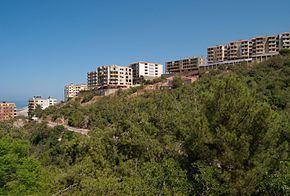Material potsherds Archaeologists V. Hankey, R. Saidah Period Bronze Age | Periods Early Bronze Age Public access Unknown | |
 | ||
Location 6 kilometres (3.7 mi) east of Khalde, Lebanon | ||
Bchamoun (Arabic: بشامون), is a village in Aley District in the Mount Lebanon Governorate of Lebanon. It has an elevation between 40m and 580m above sea level, 12 km from airport and Beirut (10 minutes by car). Bechamoun's main population was 5000, but now it exceeds 15000. Bchamoun population includes most of the Lebanese religions (Druze, Christians, and Muslims). It is the first village to raise the Lebanese flag after independence by Emir Majid Arslan.
Contents
Map of Bchamoun, Lebanon
Archaeology
An archaeological site was discovered 6 kilometres (3.7 mi) east of Khalde by V. Hankey in 1963. The site is located on the western terraces of a conical hill, west of the main village called Qalaa' Tahun-el-Haoua. An unpublished collection was also made by R. Saidah. Various potsherds were found and dated back to the Early Bronze Age by Maurice Dunand. Amongst the pottery was a sherd with a cylinder seal showing pattern of marching and alternating goats and lions that was similar to sherds showing a similar type of animalism from Byblos, Megiddo and other Palestinian and Syrian sites dating to the EB period. Although some thinner pink ware was found, sherds were usually red or grey, thick and well fired. The forms suggested were large, flat based jars with flared rims. Decorations found included incised patterns, made with combs to form bands of chevrons. Similar finds were discovered at Jaita I, Kaffer Jarra Roueisse, Nahr Damour, Aramoun and Khallet-el-Khazen. Two used flint blades were found along with part of a basalt object.
